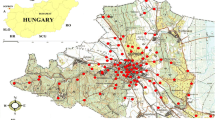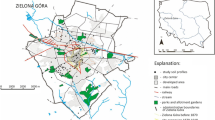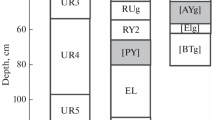Abstract
The city of Kuito is located in the Central Plateau of Angola, with elevations above 1500 m high. The soils are classified as ferralsols and arenosols, developed over laterites and clastic recent sediments of the Kalahari Group, respectively. The soils have very low clay contents, less than 3.9%, and loamy sand to sandy loam texture. The urban soil has higher pH (7.4) and electrical conductivity (267 μS/cm) levels than natural soils. To note, the latter usually have an average pH value of 5.8 and an average value of 7.2 μS/cm of electrical conductivity. There is no distinction in the organic matter content in both types of soils. Urban soil has 0.69% and the natural soil has 0.71%, of organic carbon. The urban soils also display higher concentrations of Na, P, Cu, Zn, Sn, Sb, Cd and Pb than the natural ones, and the contaminating elements in the urban soils are Cu, Zn, Sn, Sb, Cd and Pb. These elements are added to the soils by anthropic activities, such as the uncontrolled deposition of domestic and industrial effluents and car traffic. It is actually the type of soil and the modification of its pH which control these elements’ fixation in the urban soils.
Access provided by Autonomous University of Puebla. Download conference paper PDF
Similar content being viewed by others
Keywords
1 Introduction
Urbanization and automobile traffic are rapidly increasing in the developing countries, along with industrialization. The related environmental contamination may pose a serious risk for the urban residents and may adversely affect the soil ecosystem services [1,2,3].
Differences among cities, mainly in population density and industrial activities, as well as traffic density could have some impacts on the results of individual studies. Comprehensive investigations and assessments of urban soils are needed, but information is often missing in regard of some recently and rapidly developing regions [2]. In this context, the example of an expanding city with growing population, but where the industrial activities are incipient (Kuito city in Central Angola) has been selected as subject of the present study. In this region many farmers moved to the city and started to dedicate themselves to the construction and small food industries, locksmiths, metal workshop, car workshops etc. These new activities are potentially dangerous to the surrounding environment and even to human health, especially children, because the city has very deficient systems for collecting domestic and industrial wastes, which are often freely disposed of in the soil. Similarly, the liquid effluents emanating from domestic activities (baths, dishes, clothes and car washings) are freely disposed in the soil.
2 Materials and Methods
The city of Kuito is located in the Bié province, in the middle of the Central Plateau of Angola. The climate is usually hot and humid, with dry winters. The mean monthly average temperatures for the period 1901–2015 ranged from 15.5 to 20.4 °C, and the mean annual rainfall was around 1319 mm [4]. The municipality of Kuito is the most populous (424,169 inhabitants) of the Bié province, which encompasses 1,338,923 inhabitants [5]. Since the civil war, the city has grown in an uncontrolled way, without sewage and domestic wastes collection systems, urban planning and water distribution systems. Hence, serious basic sanitation related problems started to emerge. The Kuito region is mostly covered with laterites and clastic sedimentary deposits which are part of the Kalahari Group [6]. Soils in the Kuito region are ferralsols and arenosols. The arenosols have developed over the clastic sediments and are very susceptible to erosion. Ferralsols are heavily leached, but developed on laterites. They consist essentially of Al and Fe oxides, which agglomerate quartz particles giving them a sandy texture. They also have a kaolinite and a yellow to reddish colour. The urban soil samples were collected in the interior of the cities, where access was allowed and the superficial part of the profile was sampled. Natural soils were sampled where little anthropic influence was detected. Composite samples, resulting from 5 sub-samples collected in an area of about 1 m2 were collected. They were dried outdoors (while covered with paper), desegregated, sieved to <2 mm, homogenized and quartered to determine the pH, electrical conductivity (EC) and texture levels by means of laser diffraction. Organic carbon was reduced by dry combustion and analyzed through infra-red detection. Another fraction was sieved at <180 μm and analyzed via ICP-OES and ICP-MS, after digestion with aqua regia in Actlabs laboratories, with an analytical error of less than 10%.
3 Results
The urban soil proves to display significantly higher pH, CE, silt and sand contents and lower clay contents than the natural soil, with is no significant difference being noticed in regard of organic carbon values (Table 1). The pH sample/mean pH values relevant to the Kuito natural samples appeared to range from 0.98 to 1.44, the greatest amounts of which were greater than 1.2 (Fig. 1d). As for CE, the ratio values proved to range from 6.4 to 59.5 (Fig. 1e). The urban soil is richer in Mg, Ca, Na, K, P, Mn, Ba, Cu, Zn, Sn, Sb, Cd, Pb and is poorer in Al and Zr than the natural soil (Fig. 1c). The differences between the elementary contents of both soil types are more explicit by calculating the ratio between the elements’ concentration in each sample by the mean value of the element in the natural soil (Fig. 1f).
Values of pH a electrical conductivity, b trace elements, c of the soil samples collected from Kuito, and ratios of urban soil sample values/average of natural samples. Symbols filled: natural soil samples; open symbols: urban soil samples. In c and f—light green line: natural soil samples; dark green line: urban soil samples
Concerning the urban soils of Kuito, values higher than 2 for this ratio were discovered with respect to Mg, Ca, Na, K, Mn, Sr, Ba, Ni, Bi, Cu, Zn, Sn, Sb, Cd, and Hg (Fig. 1f). The heavy metals, which stand as major contaminants of the urban soils in the city of Kuito turn out tobe: Cu, Zn, Sn, Sb, Cd, Pb and Hg.
4 Discussion
Both soils are classified to stand as loamy sand to sandy loam, and the natural soil turns out to be acid, while the urban soil is discovered to be neutral. The fact that the natural soils prove to be acid is mainly due to their derivation from sands rich in quartz and iron oxides. Besides, the precipitation rate and altitude are high and the leaching is intense. The Kuito’s natural soil proves to display lower EC values which might well be due to lower pH values, which promotes more intense salt leaching. Increases in Na and P contents have their explanation in the introduction of organic wastes and detergents, while the other elements (Cu, Zn, Sn, Sb, Cd and Pb) recorded increases can be justified by the expansion of industrial activity (locksmiths, car workshops etc.), and also by the increase in traffic.
The higher values of electrical conductivity noticeable in the samples collected in the urban zone can have its justification in the contribution of salts derived from domestic effluents and small industries, both liquid and solid, which are freely discharged in the soils. The water discharged freely by washing clothes, dishes and motor vehicles add a lot of salts to the soil. The city has a small industrial structure, but in expansion due to the continuous growth in urban population, including the transformation of food, sawmills, car workshops industries, etc., that do not have effluent collection systems. Considering the Canadian Legislation [7] for soil standards, some urban soil samples turn out to be highly polluted in Cr, Zn, Sn, Sb and Pb.
5 Conclusions
The Kuito lying urban soils are discovered to display higher pH and EC values than the natural soils. Urbanization has remarkably led to their enrichment in Na, P, Cu, Zn, Sn, Sb, Cd and Pb contents. The urban soil is polluted in Cr, Zn, Sn, Sb and Pb. These elements are predominantly added to the soils by the effect of anthropic activities, such as the uncontrolled deposition of domestic and industrial effluents and car traffic.
References
Khorshid, M.S.H., Thiele-Bruhn, S.: Contamination status and assessment of urban and non-urban soils in the region of Sulaimani City, Kurdistan, Iraq. Environ. Earth Sci. 75, 1171 (2016)
Luo, X.S., Yu, S., Zhu, Y.G., Li, X.D.: Trace metal contamination in urban soils of China. Sci. Total Environ. 421–422, 17–30 (2012)
Islam, S., Ahmed, K., Al-Mamun, H.: Distribution of trace elements in different soils and risk assessment: a case study for the urbanized area in Bangladesh. J. Geochem. Explor. 158, 212–222 (2015)
CCKP.: Climate Change Knowledge Portal. http://sdwebx.worldbank.org/climateportal/index.cfm?page=country_historical_climate&ThisRegion=Africa&ThisCCode=AGO. Accessed in December 2017 (2017)
CENSO.: Resultados Preliminares do Recenseamento Geral da População e da Habitação de Angola 2014. INE, Angola. http:// censo.ine.gov.ao/xportal/xmain?xpid=censo2014&xpgid=relatórioscenso2014&actualmenu=8377701. Accessed in December 2017 (2014). (In Portuguese)
Araújo, A.G., Guimarães, F., Perevalov, O.V., Voinovsky, A.S., Tselikovosky, A.F., Agueev, Y.L., Polskoi, F.R., Khodirev, V.L., Kondrátiev, A.I.: Geologia de Angola—Notícia Explicativa da Carta Geológica de Angola à escala de 1:1000 000. Serviço Geológico de Angola, 136 p (1992). (in Portuguese)
Ministry of the Environment: Soil, Ground Water and Sediment Standards for Use Under Part XV.1 of the Environmental Protection Act (2011)
Author information
Authors and Affiliations
Corresponding author
Editor information
Editors and Affiliations
Rights and permissions
Copyright information
© 2019 Springer Nature Switzerland AG
About this paper
Cite this paper
Vinha G. Silva, M.M., Cabral Pinto, M., Dinis, P.A., Mandavela, L. (2019). Geochemistry of Urban Soil in the Fast-Growing Kuito City (Angola). In: Doronzo, D., Schingaro, E., Armstrong-Altrin, J., Zoheir, B. (eds) Petrogenesis and Exploration of the Earth’s Interior. CAJG 2018. Advances in Science, Technology & Innovation. Springer, Cham. https://doi.org/10.1007/978-3-030-01575-6_32
Download citation
DOI: https://doi.org/10.1007/978-3-030-01575-6_32
Published:
Publisher Name: Springer, Cham
Print ISBN: 978-3-030-01574-9
Online ISBN: 978-3-030-01575-6
eBook Packages: Earth and Environmental ScienceEarth and Environmental Science (R0)





